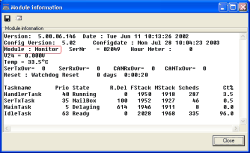Under certain conditions, a module shown in the Device tree does not carry the expected label “RM420-xxx”. Instead, “Monitor” or “Unknown type xxx” is displayed. This happens if the software of the module is in a certain mode, the so called monitor mode. In this mode, not the normal code is running on the module that otherwise does the signal processing, but a Boot Loader that is also called “Monitor”. If the module information can be displayed using the command , you can also see whether the module is in monitor mode. (see figure 12: Module information window for a module in Monitor mode.)
![[Tip]](../pics/tip.gif) | Tip |
|---|---|
In this case, Monitor is a special software mode of a module, its name has nothing to do with the term used in audio studio technology to describe monitor speakers or the monitoring of sound signals! | |
The Boot Loader is a kind of “Mini operating system” that always starts immediately after switching on the module or after a reset. It does nothing else than loading the actual operating system (also called firmware) of the module from Flash memory into the RAM of the module. Afterwards it starts the software just copied thus setting the module in normal operation. As soon as this was successful, the module signals its name “RM420-xxx” and is displayed this way in the Device tree.
If the Boot Loader was not successful copying and starting the operating system, the module remains in Monitor mode. In most cases, the reason for this is an invalid or missing software in the Flash memory of the module. In this case you have to update the firmware of the module. (see Device Firmware )
